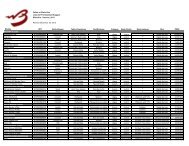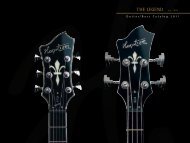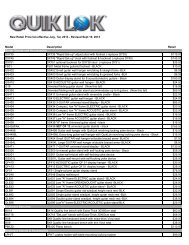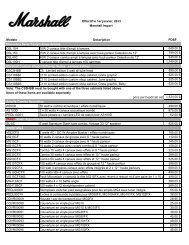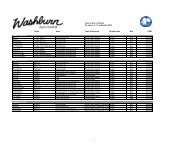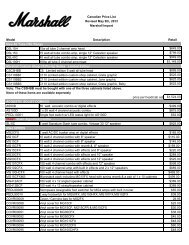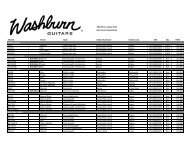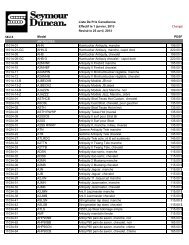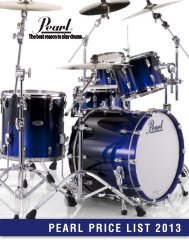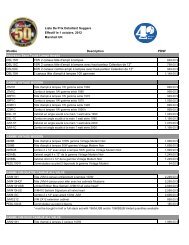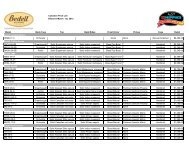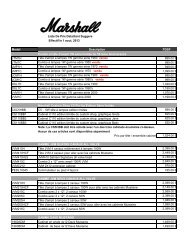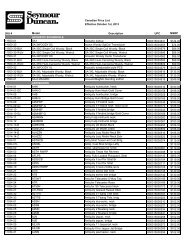How to Pick a Pickup - Seymour Duncan
How to Pick a Pickup - Seymour Duncan
How to Pick a Pickup - Seymour Duncan
Create successful ePaper yourself
Turn your PDF publications into a flip-book with our unique Google optimized e-Paper software.
FOR TONE THAT SETS YOU APART<br />
what makes one pickup sound different from another?<br />
Basically, a passive pickup is composed<br />
of two things: a magnet and a coil of<br />
insulated copper wire. The magnet<br />
works <strong>to</strong> magnetize the strings creating<br />
something called a flux field. When the<br />
strings vibrate, the movement of this<br />
flux field creates an alternating current<br />
within the pickup coils. This alternating<br />
current then travels from the pickup<br />
<strong>to</strong> the amplifier. When you crank your<br />
amp, you hear the combination of the<br />
pickup and the amplifier interpreting<br />
the vibration of the strings. When you’re<br />
thinking about how a pickup will sound,<br />
there are a few variables that determine<br />
the way it will transduce the string<br />
vibrations.<br />
coil<br />
A pickup coil is merely a long strand of<br />
insulated copper wire, wound thousands<br />
of times around a bobbin (or coil form)<br />
that has magnetic pole pieces at its<br />
core or a bar magnet at its base. We<br />
use several types of insulation and<br />
several gauges of wire <strong>to</strong> give you<br />
the right <strong>to</strong>ne. The different sizes and<br />
shapes of the bobbins have an impact<br />
of determining how the pickup will<br />
transduce the string vibration. For<br />
instance, a narrow coil that’s close <strong>to</strong><br />
the pole pieces like a Fender ® single<br />
coil results in extended treble response.<br />
A P-90, on the other hand, is shorter<br />
and fatter, yielding a more midrangeintensive<br />
<strong>to</strong>ne.<br />
number of turns<br />
The number of turns of copper wire<br />
wound around the bobbin greatly affects<br />
the performance of the pickup and the<br />
overall <strong>to</strong>ne of your guitar. A pickup<br />
with lots and lots of turns will have high<br />
output, but this output will come at the<br />
expense of dynamics and high end. A<br />
pickup with way <strong>to</strong>o many turns will<br />
actually lose output due <strong>to</strong> resistive losses<br />
caused by excessive impedance. On<br />
the other hand, an under-wound pickup<br />
will come across sounding thin and<br />
weak. Getting the right number of turns<br />
for a great-sounding pickup is as much<br />
art as it is science.<br />
d.c. resistance<br />
and resonant peak<br />
The gauge of wire and the number<br />
of turns on the coil each play a part<br />
in defining the d.c. resistance. D. C.<br />
resistance is resistance <strong>to</strong> the flow of<br />
direct current. Generally, the more turns<br />
of wire, the higher the D.C. resistance,<br />
the higher the output and the lower the<br />
treble response. For single coils, the d.c.<br />
resistance generally ranges from around<br />
6.5k for a vintage <strong>to</strong>ne, <strong>to</strong> 15k for a high<br />
output <strong>to</strong>ne. For humbuckers, the range<br />
is around 7.5k <strong>to</strong> around 16.5k. Though it<br />
may seem that this is the clear-cut way<br />
<strong>to</strong> determine what kind of pickup is best<br />
for you, remember this is only one of<br />
several variables that aid in determining<br />
the <strong>to</strong>ne or voice of a pickup.<br />
Resistance <strong>to</strong> the flow of alternating<br />
current is called impedance and it<br />
changes with frequency. The frequency<br />
where a pickup’s impedance reaches<br />
its highest level is called the resonant<br />
peak. Generally speaking, the higher in<br />
frequency the resonant peak, the clearer<br />
and brighter the pickup’s <strong>to</strong>ne.<br />
The relationship between d.c. resistance<br />
and resonant peak is a great way <strong>to</strong><br />
understand the voice and <strong>to</strong>ne of a<br />
<strong>Seymour</strong> <strong>Duncan</strong> or Basslines pickup.<br />
For example, if you check out the <strong>to</strong>ne<br />
chart you can see that an SSL-2 Vintage<br />
Flat for Strat ® has a significantly higher<br />
resonant peak (9.0 KHz) than, say, a<br />
similar pickup like an SSL-3 Hot for<br />
Strat ® (4.4 KHz).<br />
Based on these numbers, you can easily<br />
see that the Vintage has a much brighter<br />
<strong>to</strong>ne and the Hot has a much fatter <strong>to</strong>ne.<br />
Or, if you see that the Vintage (6.6k) has<br />
a much lower d.c. resistance than the<br />
Hot (16.4k), you will understand that<br />
the Vintage has less output and more<br />
brightness compared with the Hot.<br />
Notice the inverse relationship between<br />
d.c. resistance and resonant peak.<br />
Generally speaking, the higher in<br />
frequency the resonant peak, the clearer<br />
and brighter the pickup’s <strong>to</strong>ne.<br />
We list the D.C. resistance and resonant<br />
peak for almost all of our pickups.<br />
It’s most informative <strong>to</strong> compare<br />
D.C. resistance and resonant peaks<br />
between similar pickups, that is,<br />
between single coils or between<br />
full-size humbuckers for example,<br />
and not across broad categories,<br />
like comparing a single coil <strong>to</strong> a<br />
full-size humbucker. Besides<br />
actually hearing the pickup, this<br />
is the best way <strong>to</strong> figure out<br />
what the pickup is going<br />
<strong>to</strong> sound like.



